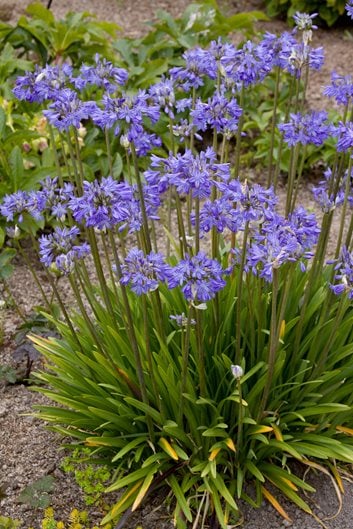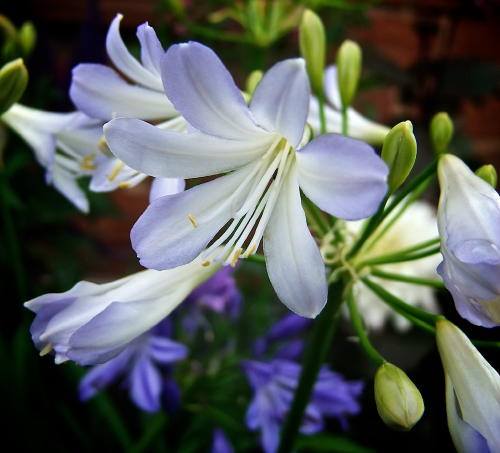Grasping the Art of Agapanthus Care: Vital Actions for Healthy And Balanced Development and Vibrant Flowers
In the world of horticulture, the cultivation of agapanthus stands as a satisfying undertaking for those who seek to nurture these stylish blooming plants. With their striking blossoms and elegant foliage, agapanthus has actually caught the interest of gardeners worldwide. However, accomplishing ideal growth and dynamic blooms requires a nuanced method that encompasses various crucial steps. From picking the appropriate selection to grasping pruning methods, the journey towards cultivating thriving agapanthus plants is complex and holds the vital to opening the complete possibility of these organic gems.

Picking the Right Agapanthus Selection

When picking the appropriate Agapanthus selection for your garden, think about aspects such as environment viability, bloom color, and development practice. Agapanthus, frequently referred to as Lily of the Nile or African lily, can be found in a variety of colors ranging from shades of purple and blue to white. Pick a bloom color that matches your existing yard palette to create an unified landscape. Additionally, take into consideration the climate in your region to guarantee the Agapanthus variety you pick can prosper in your particular conditions. Some selections are a lot more tolerant of cool temperature levels, while others favor warmer environments. Comprehending the growth behavior of various Agapanthus ranges is crucial for correct placement within your garden. Some ranges have a clumping development practice, suitable for containers or borders, while others have an even more dispersing nature, suitable for ground cover or mass plantings. By meticulously reviewing these aspects, you can choose the perfect Agapanthus variety to enhance the appeal of your garden.
Ideal Planting Conditions
Thinking about the optimal environmental demands is essential for successful Agapanthus cultivation. Agapanthus thrives in well-draining soil with a somewhat acidic to neutral pH degree. When growing, choose a location that obtains full sunshine to partial color. In hotter environments, offering some mid-day color can protect against scorching of the leaves. Agapanthus plants are sensitive to cool temperatures and need to be secured from frost throughout wintertime months.
To make sure healthy growth and vibrant flowers, plant Agapanthus bulbs at a depth of regarding 2-4 inches and area them 8-12 inches apart. Mulching around the base of the plants assists keep wetness and subdues weed development.
Watering and Feeding Tips
Keeping appropriate dampness degrees and giving vital nutrients are vital components in the treatment regimen for Agapanthus plants. When it comes to sprinkling Agapanthus, it is important to strike a balance. These plants choose continually damp soil but are prone to root rot if overwatered.
Fertilizing Agapanthus is important for promoting healthy and balanced development and respected blossoms. Apply a well balanced fertilizer, such as a 10-10-10 formula, in the very early springtime as brand-new growth emerges. By adhering to these watering and fertilizing tips, you can ensure your Agapanthus plants grow and generate vivid, durable blossoms.
Pruning Strategies for Agapanthus
Trimming Agapanthus plants at the proper times and with proper methods is important for preserving their health and wellness and advertising ideal growth and flowering. The ideal time to trim Agapanthus is in late winter months or very early springtime before brand-new growth emerges.
Deadheading spent blossoms can also reroute the plant's energy right into generating even more blooms instead than setting seeds. If you want to collect seeds for propagation, leave some flowers to fully grown and completely dry on the plant.
Keep in mind to make use of tidy, sharp devices to make exact cuts and lower the danger of presenting diseases. Agapanthus. Normal trimming will certainly aid keep your Agapanthus looking neat and healthy while guaranteeing a bountiful screen of lovely blossoms
Handling Common Bugs and Conditions
After making sure appropriate pruning strategies for Read More Here Agapanthus, it is essential to attend to usual insects and conditions that can influence the health and vitality of these plants. One common pest that impacts Agapanthus is the Agapanthus gall midge.
An additional usual issue is fungal fallen leave spot, which provides as dark sores on the leaves. To avoid fungal conditions, ensure great air blood circulation around the plants, stay clear of above watering, and remove any type of infected fallen leaves quickly. In addition, Agapanthus plants can endure from webpage origin rot if they are planted in inadequately draining soil. To stop this, plant Agapanthus in well-draining dirt and stay clear of overwatering. By being attentive and taking prompt action against diseases and bugs, you can help your Agapanthus plants prosper and produce dynamic blooms.

Verdict
In verdict, grasping the art of agapanthus treatment involves selecting the right range, supplying ideal planting conditions, correct watering and fertilizing, ideal trimming methods, and attending to common parasites and illness. By following these necessary actions, you can make sure healthy and balanced development and vibrant blossoms for your agapanthus plants. Bear in mind to regularly check and maintain your plants to promote their general well-being and durability.
To view publisher site make certain healthy and balanced growth and lively blooms, plant Agapanthus bulbs at a deepness of concerning 2-4 inches and area them 8-12 inches apart. By following these watering and feeding pointers, you can guarantee your Agapanthus plants grow and produce dynamic, durable blossoms.
One common insect that influences Agapanthus is the Agapanthus gall midget. In addition, Agapanthus plants can endure from origin rot if they are planted in badly draining pipes dirt. By complying with these crucial steps, you can ensure healthy growth and vivid blossoms for your agapanthus plants.